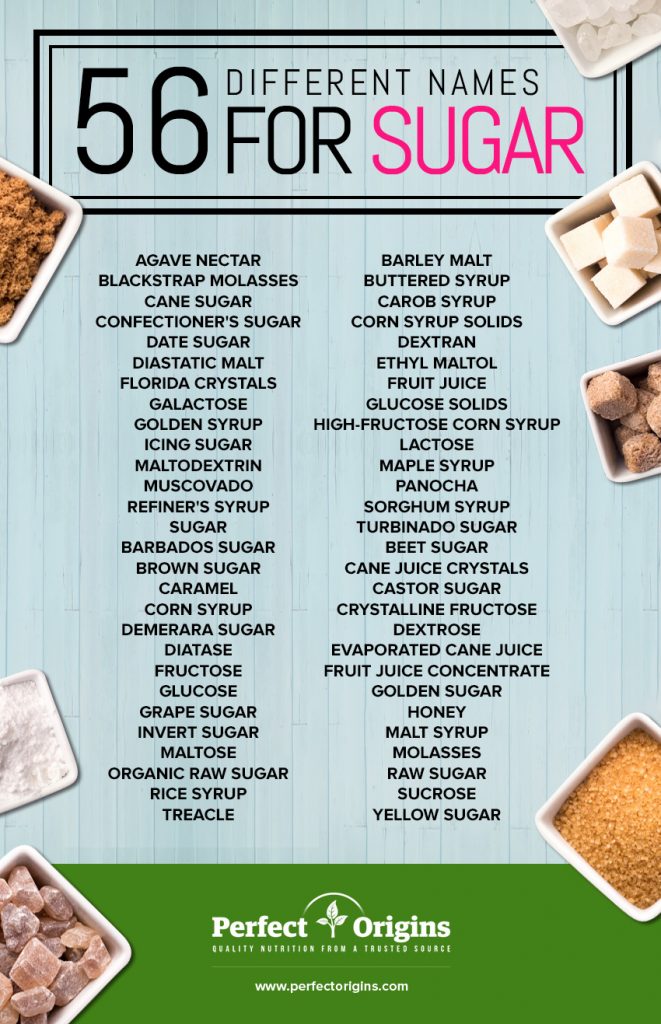Eating too much sugar is a surefire way to gain unwanted pounds, destroy your digestive health and increase your risk for type 2 diabetes, cardiovascular disease, obesity and a raft of other modern diseases.
That’s why most of us limit the amount of cookies, donuts, soda and other sugary foods we consume.
But most people don’t realize how much added sugar is hidden in savory foods like pasta sauce, bread, salad dressing and frozen dinners. In fact, of the 600,000 or so food items available in America a whopping 80% or more contain added sugar.
Not that you’d ever know this from reading the product labels.
56 Names For Sugar : Hidden In Plain Sight
The U.S. Food and Drug Administration (FDA) requires food manufacturers to list all of the ingredients included in their products.
You may be reading labels to try and avoid eating foods loaded with sugar. But added sugar is often hidden in plain sight: it’s regularly listed on food labels under a variety of inventive — and deceptive — names.
There are more than 56 different names for sugar used by food manufacturers in the United States.
Some like sucrose and high-fructose corn syrup are easy to spot. Others like Florida crystals, golden syrup and beet sugar conjure up images of health and vitality.
After all, beets are good for you. So sugar derived from beets must be fairly healthy too, right? Wrong.
Here are 56 different names for sugar you need to watch out for:

When you consider all the ways the multi-billion dollar Big Food industry is sneaking sugar into their products, it’s no surprise that most Americans are consuming way too much sugar.
On average, Americans consume 66 pounds of added sugar per year!
How Much Sugar Is Too Much?
You won’t find recommended daily amounts for sugar printed on food labels.
But according to the American Heart Association men should consume no more than 9 teaspoons (38 grams) of added sugar per day, and women no more than 6 teaspoons (25 grams).
To give those numbers some perspective consider the fact that the typical 12-ounce can of soda has as many as 11 teaspoons (46.2 grams) of added sugar.
That means a single can of soda exceeds the AHA’s recommendation for men and is almost DOUBLE the allowance for women and children.
“Healthy” Foods Are Often Sugar Traps
Avoiding added sugar gets even trickier when many healthy-looking products at your grocery store are actually sugar traps:
- One popular brand of “fat free” yogurt contains 10 grams of sugar — nearly as much added sugar as three Oreo cookies!
- A leading “nutrition energy bar” marketed to dieters and health-conscious consumers contains 17 grams of added sugar.
- A single 8-ounce serving of a cranberry/pomegranate juice blend that advertises “no high-fructose corn syrup” and “100% vitamin C” contains a whopping 30 grams of sugar.
- A leading raisin bran breakfast cereal contains 20 grams of sugar per serving.
And the list goes on and on.
If you’re worried your healthy diet may, in fact, be harming your health and adding pounds of squishy, embarrassing flab to your midsection, please pay attention.
There are five specific so-called health foods you may have in your kitchen right now, that are notorious for damaging your liver and triggering belly fat. Get the full scoop on these five foods you must avoid.
What You Can Do To Protect Yourself And Your Family
Overconsumption of added sugar poses a serious risk to your health.
Unfortunately, the deceptive practices of many food manufacturers make it more difficult than it needs to be to make healthy food decisions.
When added sugar is hidden on food labels under names like “Florida crystals” and “muscovado” you’re not always sure what you’re eating.
One way to minimize your risk of eating too much added sugar is to pay close attention to the total grams of sugar in all of the foods you buy — and especially those marketed to you as healthy.
Remember the American Heart Association’s recommendations for daily sugar consumption and then strive to stay below that number.
Another habit to cultivate is eating more whole foods — fruits and vegetables in particular.
Fruits do contain sugar (in the form of fructose) but typically their sugar content is much lower than what you’d find in a similarly sized processed food. Plus, you’ll get a dose of vitamins and minerals that most processed foods are lacking.
Finally, if want to restore balance to your body by saying goodbye to sure, check out our ultimate guide on How to Detox from Sugar.


